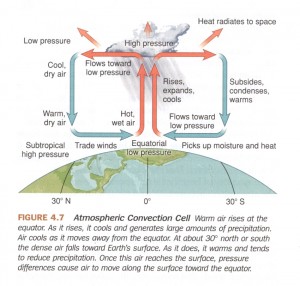Because of Earth’s axial tilt, curvature, and rotation, we tend to have a surplus of energy near the equator and a deficit near the poles. Faced with this stark inequality, our atmosphere plays the part of Robin Hood—taking from the energy surplus and giving to the energy deficit. This process of transferring energy from the equator poleward is known by atmospheric scientists as the general circulation of the troposphere. We will see in upcoming blogs that our atmosphere, even with its greatest attempts to reach equality, can never quite balance this energy budget occurring on Earth’s surface.
To describe general circulation, we are going to follow an air parcel as it flows from the equator northward.
Our parcel’s journey begins at the equator, where energy is “laying around” in large quantities. Through absorption of this extra energy, the parcel increases its temperature and, therefore, decreases its density. At some point, our parcel’s density becomes less than the environment around it, and so it rises to the top of the troposphere. An example analogous to this movement would be when you release an inflatable ball from the bottom of a swimming pool.
When our parcel reaches the top of the troposphere, called the tropopause, it stops rising and is forced instead to move either north or south. A nice way to think about this transaction is by considering a bottle of toothpaste. For instance, if you cap your toothpaste bottle, then, when you go to squeeze your toothpaste upwards, it will actually be forced by the cap to move horizontally. The same concept occurs in the tropopause. Suffice it to say that, in this case, our parcel chooses north as its intended path of travel.
We know from last blog what happens to parcels traveling north from the equator. They must obey geostrophic flow.
Therefore, while initially moving northward, our parcel is continuously reflected ninety degrees to its right by the Coriolis force until it is moving perfectly eastward. In doing so, the parcel never makes it to the north pole, its intended destination. In fact, calculations can show that it gets stuck around 30°N.
Many air parcels “pile up” at this 30°N location, creating a stream of air that encircles the earth below it. Intentionally, we call this pile up of moving air the subtropical jet stream. In central Pennsylvania, we usually do not experience much from this stream of air, and if we do, it occurs during the summer months, when the subtropical jet stream is slightly north of 30°N. Most of the time, we are victims of what is called the mid-latitude jet stream, a structure much more difficult to understand that I may take about in future blogs.
As you might imagine, things can get pretty heavy in the subtropical jet stream when more and more air parcels enter it, and so the air eventually sinks due to gravitational forces. Not unlike what happens at the tropopause when air rises, air that sinks towards the surface, too, has a choice to move north or south. This time, let us say for the sake of discussion that the air parcel chooses to move south, back to the equator.
Ignoring frictional forces, we have yet another case of geostrophic flow. Instead of moving initially northward, however, our parcel is moving southward. Therefore, when our air parcel is deflected continuously to its right, the direction of travel becomes an easterly wind (wind that flows from the east to the west). This easterly flow is known as the trade winds, famous for helping Europeans sail to the Americas during the times of colonialism.
As you can see, once the parcel reaches the equator (which it will just barely do because of the Coriolis deflection), the process begins anew. We call this cycle the Hadley Cell; it is the fundamental description of average atmospheric motion in the tropics. (To understand what happens above our heads, in the mid-lattitudes, requires more sophistication but, in general, follows similar principles displayed in the Hadley Cell.)
An illustration of the Hadley Cell can be shown below.


3 responses to “Hadley Cells: The Foundations of Atmospheric Circulation”